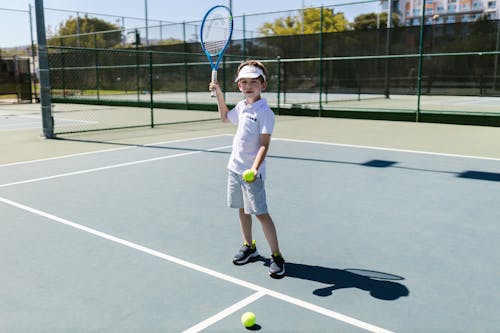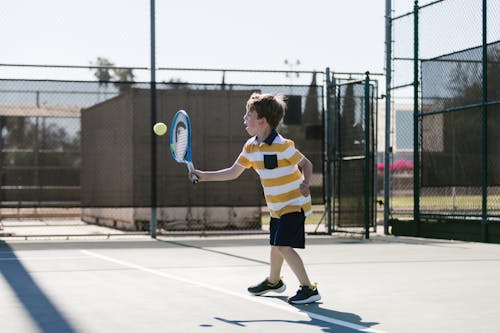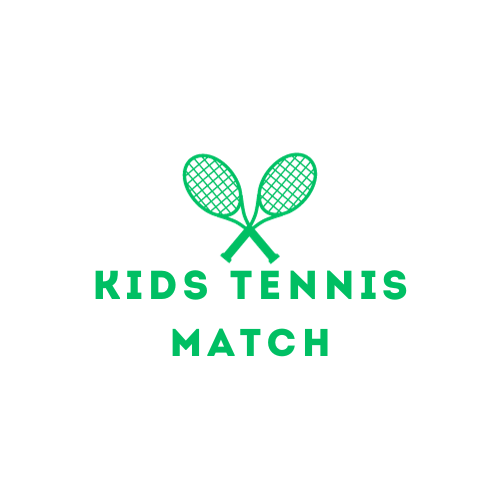If your child is passionate about tennis and wants to take their game to the next level, improving their tennis reflexes is key. It’s not just about hitting the ball with power or precision, but also being able to react quickly and anticipate their opponent’s moves. Developing fast and agile reflexes will not only enhance their performance on the court, but also boost their confidence and overall game play. In this article, we will explore some effective strategies and exercises that can help your child improve their tennis reflexes and become a more formidable player. So, let’s get started and give your child the competitive edge they need!
1. Basic techniques to improve tennis reflexes
1.1 Footwork drills
Good footwork is crucial for a tennis player to maintain balance and mobility during a match. By incorporating footwork drills into your child’s training routine, you can significantly improve their reflexes on the court. One effective drill is the ladder drill, where your child can practice quick and precise foot movements by stepping in and out of ladder rungs at varying speeds. Another helpful drill is the agility ladder drill, which involves moving laterally through a series of cones or markers placed in a zigzag pattern, improving their footwork and reaction times.
1.2 Reaction drills
When it comes to improving tennis reflexes, reaction drills are essential. These drills aim to enhance your child’s ability to react quickly to different game situations. One popular drill is the “mirror drill,” where your child mirrors the movements of their partner, requiring them to react instantaneously. Another effective reaction drill is the “drop-shot drill,” where your child practices quick movement towards the net to reach and return a drop shot. By performing these reaction drills regularly, your child will become more adept at responding swiftly to their opponent’s shots.
1.3 Shadow swings
Shadow swings are a great way to enhance your child’s muscle memory and develop their tennis reflexes. This technique involves mimicking the full range of shots without a ball. By performing shadow swings, your child can focus on their technique, footwork, and timing without the pressure of hitting an actual ball. Encourage your child to visualize their opponent’s shots and practice a variety of strokes, including forehands, backhands, volleys, and serves. Shadow swings can be done at home or on the court, providing an excellent opportunity for your child to refine their tennis skills.
2. Incorporating agility exercises
2.1 Ladder drills
Agility ladder drills are a fantastic way to improve your child’s agility, coordination, and overall reflexes on the tennis court. These drills involve a ladder-like structure placed on the ground, where your child performs a series of footwork patterns by stepping in and out of the ladder rungs. This exercise not only enhances their foot speed but also sharpens their reaction time. By incorporating ladder drills into your child’s training regimen, you can boost their ability to quickly change direction and respond to different shots during a match.
2.2 Cone drills
Cone drills are another effective method to enhance your child’s agility and reflexes. These drills involve setting up a series of cones or markers in a specific pattern and having your child navigate through them quickly and efficiently. The unpredictability of the cone arrangements helps simulate real game scenarios and challenges your child’s reaction time and ability to change direction instantly. By practicing cone drills regularly, your child will develop the agility and reflexes necessary to react swiftly to their opponent’s shots.
2.3 Plyometric exercises
Incorporating plyometric exercises into your child’s training routine can significantly improve their power, speed, and explosiveness on the tennis court. Plyometrics involve explosive movements such as jumps, hops, and bounds that engage your child’s fast-twitch muscle fibers, ultimately enhancing their reflexes. Exercises like box jumps, lateral bounds, and squat jumps can be beneficial for developing explosive power and improving reaction time. However, it’s important to ensure that these exercises are performed under proper supervision and gradually progressed to avoid the risk of injury.

3. Enhancing hand-eye coordination
3.1 Wall hitting drills
Wall hitting drills are an excellent way to enhance your child’s hand-eye coordination and reflexes. By hitting the ball against a wall and reacting to its rebound, your child can practice tracking the ball and developing quick reflexes. Start with simple forehand and backhand shots, and gradually progress to more challenging shots, such as volleys and smashes. Additionally, varying the speed and angle of the shots will further challenge your child’s hand-eye coordination, helping them become more adept at reacting to different types of shots during a match.
3.2 Ball toss and catch exercises
Ball toss and catch exercises are a fun and effective way to improve your child’s hand-eye coordination and reflexes. Start by tossing a tennis ball to your child and having them catch it with their racket. As they become more comfortable, increase the height and speed of the toss, challenging their reflexes. This exercise not only improves hand-eye coordination but also enhances their focus and concentration. It can be done individually or as a game, making it an enjoyable way for your child to improve their tennis skills.
3.3 Racket tapping drills
Racket tapping drills are a simple yet valuable technique to enhance your child’s hand-eye coordination and reflexes. This exercise involves tapping a tennis ball with their racket repeatedly without allowing it to touch the ground. Encourage your child to tap the ball with both sides of their racket, improving their coordination and ability to react quickly. Additionally, you can increase the difficulty by using a smaller ball or introducing multiple balls simultaneously. Racket tapping drills can be included as a warm-up activity before practice or incorporated into their regular training sessions.
4. Utilizing specific tennis training aids
4.1 Reaction ball
A reaction ball is a specialized training tool that can significantly improve your child’s reflexes and reaction time on the tennis court. This small, unpredictable ball bounces in various directions, forcing your child to react quickly and adjust their position accordingly. By incorporating reaction ball exercises into their training, your child can enhance their agility, coordination, and anticipation skills. These exercises can include bouncing the ball against a wall and reacting to its rebound, or tossing the ball towards your child and having them catch or hit it. Reaction balls are easily portable, making them ideal for on-the-go training.
4.2 Balance board
A balance board is a versatile tool that can be incorporated into your child’s tennis training to improve their stability, core strength, and overall body control. By standing on a balance board, your child engages their stabilizer muscles and improves their proprioception. This heightened body awareness can significantly enhance their on-court reflexes and ability to quickly adjust their position. Balance board exercises can include single-leg stands, squats, and lunges, gradually progressing to more challenging movements as your child’s balance improves. Incorporating a balance board into their training routine can provide a fun and effective way to enhance their tennis reflexes.
4.3 Speed ladder
A speed ladder is a valuable training aid that can help your child improve their footwork, agility, and overall quickness on the tennis court. By performing drills using a speed ladder, your child can enhance their reaction time, coordination, and foot speed. Exercises like two-feet in, single-leg hops, and lateral shuffle can be performed using a speed ladder, challenging their ability to rapidly change direction and adjust to different shots. The speed ladder can be easily assembled and used either indoors or outdoors, providing a convenient way for your child to improve their tennis reflexes.

5. Mental and cognitive training
5.1 Visual tracking exercises
Visual tracking exercises are an essential aspect of developing your child’s tennis reflexes. These exercises focus on improving their ability to track the ball and anticipate its trajectory. One effective exercise is having your child stand at the baseline while you feed them balls from the opposite end of the court. Their task is to track the ball’s movement and call out whether it will land in or out. This exercise enhances their visual perception and helps them react more quickly to shots during a match.
5.2 Decision-making drills
Tennis requires split-second decision-making, and drills that simulate game scenarios can be instrumental in improving your child’s reflexes. Set up different scenarios such as practicing passing shots, returning serves, or playing out points with predetermined rules. By regularly engaging in these decision-making drills, your child will develop the ability to quickly assess the situation and respond with the most effective shot.
5.3 Focus and concentration techniques
Maintaining focus and concentration is vital for improving tennis reflexes and overall performance on the court. Encourage your child to incorporate focus and concentration techniques into their training routine, such as visualization exercises, deep breathing, and mindfulness techniques. These practices can help calm their mind, reduce distractions, and enhance their ability to react quickly to various shots. Additionally, incorporating mental training exercises into their practice sessions can lead to improved mental toughness and resilience in competitive matches.
6. Playing competitive matches
6.1 Regular practice matches
One of the best ways for your child to improve their tennis reflexes is by regularly participating in practice matches. These matches provide valuable opportunities for your child to apply the skills they have learned in training and put them into practice under game-like conditions. By engaging in practice matches against different opponents, your child can further develop their reflexes, adaptability, and strategic thinking. Encourage them to focus on reacting quickly to shots, anticipating their opponent’s next move, and making efficient shot selections.
6.2 Match-like scenarios
In addition to practice matches, incorporating specific match-like scenarios into your child’s training can be highly beneficial for their tennis reflexes. Simulate different game situations, such as practicing return of serves, playing tiebreakers, or focusing on specific shot patterns. By exposing your child to these scenarios, they can fine-tune their reflexes, decision-making abilities, and strategy execution. Gradually increasing the intensity of these match-like scenarios will prepare your child for the challenges they will face in actual competitive matches.
6.3 Tournament participation
Participating in tournaments is a crucial step in improving your child’s tennis reflexes and overall game. Tournaments provide a competitive environment that pushes your child to perform at their best and hones their reflexes under pressure. The experience gained from playing against different opponents with varying styles of play can help your child sharpen their reflexes, adaptability, and mental fortitude. Encourage your child to participate in tournaments at appropriate skill levels to further develop their tennis reflexes and gain valuable competitive experience.

7. Working with a coach or trainer
7.1 Professional guidance
Working with a qualified tennis coach or trainer can greatly enhance your child’s tennis reflexes. A professional coach can evaluate their technique, footwork, and overall game, providing personalized guidance to improve their reflexes. Coaches can also introduce specific drills and exercises tailored to your child’s needs, pushing them to their fullest potential.
7.2 Customized training plans
A coach or trainer can develop customized training plans for your child, incorporating a combination of techniques and exercises to specifically target their reflexes. These plans will take into account your child’s current skill level, goals, and areas for improvement. By following a structured training plan, your child can progressively enhance their tennis reflexes over time.
7.3 Individualized feedback and corrections
Working closely with a coach or trainer allows your child to receive continuous feedback and corrections on their technique and game. This individualized attention can help them fine-tune their reflexes, identify areas of weakness, and make necessary adjustments. Coaches can provide valuable insights and strategies to improve their reaction time, shot selection, and overall performance on the court.
8. Importance of physical fitness
8.1 Strength and conditioning exercises
Physical fitness plays a vital role in improving tennis reflexes. Incorporate strength and conditioning exercises into your child’s training routine to develop their overall athleticism and explosiveness. Exercises like squats, lunges, push-ups, and plyometric drills can enhance their power, speed, and agility on the court, ultimately improving their reflexes.
8.2 Flexibility and agility training
Flexibility and agility are key components of tennis reflexes. Encourage your child to engage in regular stretching routines to improve their flexibility, which in turn will enhance their range of motion and reaction time. Additionally, agility training exercises such as ladder drills and cone drills can further improve their reflexes and quickness on the court.
8.3 Endurance workouts
Endurance is crucial in tennis, as matches can be physically demanding and require sustained effort. Incorporate endurance workouts such as running, cycling, or swimming into your child’s training routine. By improving their cardiovascular fitness, your child can maintain optimal performance throughout matches, enabling them to react quickly and effectively to shots.

9. Balancing rest and recovery
9.1 Rest days
While consistent training is important, it is equally vital to incorporate rest days into your child’s schedule. Rest days allow their body to recover and rejuvenate, reducing the risk of overuse injuries and mental burnout. Ensuring proper rest between training sessions will enable your child to maintain peak performance and optimize their reflexes during practice matches and tournaments.
9.2 Adequate sleep
Getting enough sleep is crucial for your child’s overall health and well-being, as well as their tennis performance. During sleep, the body repairs and regenerates itself, supporting optimal cognitive function and physical recovery. Adequate sleep enhances your child’s reflexes, focus, and concentration on the court. Encourage a consistent sleep schedule and create a relaxing bedtime routine to ensure they get the recommended amount of sleep for their age.
9.3 Injury prevention measures
Injuries can significantly hamper your child’s tennis reflexes and overall performance. Emphasize injury prevention measures such as proper warm-up and cool-down routines, adequate hydration, and wearing appropriate footwear and protective gear. Additionally, incorporating strength and conditioning exercises, as well as flexibility training, can help reduce the risk of injuries and support your child’s reflex development.
10. Consistency and perseverance
10.1 Regular practice schedule
Consistency is key when it comes to improving tennis reflexes. Encourage your child to follow a regular practice schedule, setting aside dedicated time for training each day or week. Consistent practice allows for the repetition and reinforcement of skills, helping your child develop and refine their tennis reflexes over time.
10.2 Patience and determination
Improving tennis reflexes requires patience and determination, as progress may not always be immediate. Remind your child to stay focused, remain positive, and persevere even in the face of challenges. By maintaining a growth mindset and embracing the learning process, your child can continue to develop their tennis reflexes and reach their full potential.
10.3 Setting realistic goals
Setting realistic goals can provide your child with a sense of direction and motivation in their tennis journey. Encourage them to set specific and attainable goals related to their reflexes, such as improving reaction time or footwork. By breaking down larger goals into smaller, achievable milestones, your child can stay motivated and track their progress over time.
In conclusion, improving tennis reflexes requires a comprehensive approach that includes various techniques, exercises, and mental training strategies. By incorporating footwork drills, reaction drills, and shadow swings, your child can develop the foundation for quick and precise movements on the court. Agility exercises such as ladder drills, cone drills, and plyometrics can further enhance their overall speed and agility. Hand-eye coordination can be improved through wall hitting drills, ball toss and catch exercises, and racket tapping drills. Utilizing specific tennis training aids like the reaction ball, balance board, and speed ladder can provide additional challenges and opportunities for growth. Mental and cognitive training, such as visual tracking exercises, decision-making drills, and focus techniques, can sharpen your child’s reflexes and mental fortitude. Playing competitive matches, working with a coach or trainer, maintaining physical fitness through strength, flexibility, and endurance training, balancing rest and recovery, and cultivating consistency, patience, and perseverance are all vital components of improving tennis reflexes. By following these comprehensive techniques and strategies, your child can enhance their reflexes and elevate their performance on the tennis court.

